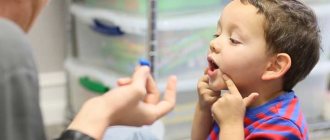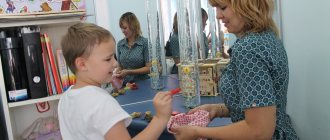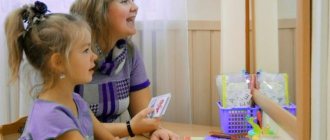Does your child still not speak? Are you worried that he is falling behind his peers? Regular sessions with a speech therapist didn’t work?
The perception and reproduction of speech are very complex processes in which different parts of the brain are involved, and scientists have not come to a consensus in describing their nature. However, the generally accepted thesis is that for normal perception and speech reproduction, the coordinated work of the centers responsible for movement and perception is necessary. Scientists and teachers also agree that the main reasons for the absence and underdevelopment of speech are:
- in the missing or “broken” connection between these centers;
- the fact that the child cannot correlate a specific object with any symbol - it can be a movement, an object, a visual or an auditory sign.
Our language is a sign system, a set of symbols that have a certain meaning. In order for speech to “start”, according to T.V. Gruzinova, it is necessary to develop a symbolic function in the child. She suggests using play speech therapy when all the necessary functions and processes return to normal precisely when the child is positively tuned to the game and is emotionally involved in it.
As a result of regular classes using the method of T.V. Gruzinova, speech appears relatively quickly and begins to develop in accordance with age.
How does speech launch using Gruzinova’s method take place?
To successfully stimulate speech, it is necessary to determine at the diagnostic stage:
- does the baby understand spoken speech and commands;
- does he have voluntary and involuntary vocalizations of vowel sounds; v
- can he imitate individual sounds when he is emotionally involved in the game.
Gruzinova calls involuntary those sounds that a child makes during some action, for example, when playing, but cannot consciously repeat at the request of an adult. Arbitrary sounds appear when the child already more or less controls his own speech apparatus and can pronounce this or that sound at will or in imitation of an adult.
First stage
At the beginning of the lesson, the speech therapist creates a game situation so that the child has a positive attitude towards working together. The exercises are aimed at challenging and reinforcing consonant sounds, the pronunciation of which the child cannot control.
The adult creates in the child an association of the movement of a sounding toy or other object (for example, a musical instrument) with a specific gesture. When a sound occurs during the game, it is accompanied by this gesture, this happens until the child remembers it and is able to repeat it as directed by an adult. The movement of the object and the gesture must correspond to only one consonant.
As the skill develops, the speech therapist teaches the child those consonants that are not in his “speech”. It creates sounds by blowing air and creating natural barriers in the form of the child's speech organs. The resulting consonants are also reinforced in the game through stable associations with the gesture and movement of the toy.
If any important sound is missing, it is formed according to the same principle, through imitation. The quality of the pronounced sound does not matter; the fact that it is present is considered success, and the child is generally able to reproduce it.
A method for stimulating speech in non-speaking children
The invention relates to speech therapy and can be used in teaching spoken language to non-speaking children with severe articulatory difficulties and difficulties in phonemic discrimination. There are 3 stages of stimulating speech in a child. At the first stage, the pronunciation of involuntary consonant sounds is challenged and reinforced in a play situation, using the association of the movement of an object with a gesture to enable the child to reproduce them voluntarily. At the same time, the sound obtained during the game is accompanied by a gesture associated with the movement of the object, until a stable relationship is formed between a specific sound and a specific gesture with an object, and the gesture and the movement of the object must indicate one sound. Next, they teach the pronunciation of consonant sounds that are absent in the child’s speech by forming a blowing air stream with the creation of an obstacle using the articulatory organs and consolidating consonant sounds in a play situation, using the movement of an object and a gesture to pronounce sounds, and the gesture and the movement of the object must indicate one sound. At the second stage, training is carried out to complete the pronunciation of a word by using the effect of gravity of an unstressed syllable to a stressed one and/or an unstable note to a stable one and/or to the completion of the rhythmically specified structure of the word. Next, words are taught with two or more open syllables and one closed syllable. At the third stage, training is carried out to pronounce the phrase using simultaneously its rhythmic and melodic structure, gestures, pictures and/or objects denoting the entire word. The method allows you to speed up the evocation of sounds, voluntary pronunciation of sounds, and also increase the effectiveness of teaching a child to pronounce words through speech therapy techniques. 1 salary f-ly,
The invention relates to speech therapy and can be used in teaching spoken language to non-speaking children with severe articulatory difficulties and difficulties in phonemic discrimination.
Speech perception is an extremely complex phenomenon. Sound waves that carry information about various features of speech sounds are highly diverse and unstable. The characteristics of the same sound can change depending on the timbre of the interlocutor’s voice, on his emotional state, on the position of the sound in the word (a certain sound is at the beginning or end of the word). At the moment, there are two main theories of speech perception. Each of them has its own strengths and weaknesses. The sensory theory assumes that the perceived acoustic signal is sequentially processed in the auditory analyzer and compared with the existing standard. When processing a signal, acoustic features are transformed into auditory sensations, then phonetic features are extracted from them and a perceptual image is created, which includes a description of many features of the signal. But it turns out that the acoustic characteristics of speech sounds vary so widely that it is almost impossible to distinguish them. However, a number of concepts have also been developed to explain the operation of the auditory analyzer. Some of them assume the presence of an innate receptive ability, while others assume the formation of this ability during ontogenesis on the basis of linguistic experience. According to the motor theory of speech perception, audio signal processing occurs in connection with the activation of motor articulations. The perception of an acoustic signal is associated with the automatic activation of motor impulses that reproduce the incoming signal. Recognition of an incoming acoustic stimulus is carried out on the basis of comparison of these motor commands with existing standards. But this theory also encounters its difficulties. Motor standards are formed based on speech practice. From the motor theory it follows that a child who does not speak speech does not distinguish audible speech. But that's not true. Typically, speech understanding precedes the onset of speech production.
There is still no consensus on issues related to the mechanisms of speech perception. However, the generally accepted position is that both speech perception and reproduction depend on the emergence and adequate joint functioning of the motor and sensory centers. Normally, this connection can form quite early. But, despite the existence of such a possibility, it is not always realized. The delay in the appearance of speech in children is often explained precisely by the blocking of this connection. Another common difficulty in mastering speech is a lag in the formation of symbolic function in a child. J. Piaget, based on a study of infant development, put forward the concept of symbolic function as the ability to replace a really existing object with a sign of various modalities (motor, object, visual, auditory). For mastering speech (at least in the initial stages), what is important is not the intellectual development of the child as a whole, but the level of development of the symbolic function.
The process of stimulating speech in non-speaking children is preceded by a diagnostic process, when several aspects are assessed, including how much the child understands the spoken speech and instructions.
If the child does not speak, then pay attention to the presence of voluntary and involuntary vocalizations, as well as the ability to imitate sounds in a situation of emotional involvement.
To implement the proposed method, it is also necessary to establish trusting physical and emotional contact with the child. Since the process of stimulating speech also involves physical impact, including in the facial area, the child may experience unpleasant emotions and sensations. It is important to maintain a good, emotionally safe relationship: to encourage the child to do something, using his motivation, interests, and emotional contagion.
There is a known method of teaching a child speech mainly by the imitation method, carried out by relying on real objects, which uses the education of auditory concentration while listening to singing, the sound of musical toys and instruments (L.P. Fedorenko, G.A. Fomicheva, V.K. Lotarev " Methodology for the development of speech in preschool children,” M., 1977).
There is a known method of stimulating speech in non-speaking children with disabilities in the development of intelligence, which includes conducting classes in a playful mode, presenting visual information and pronouncing speech material in the form of words and sentences in the form of a dialogue, in which the articulation of sound, words, simplest sentences and video images corresponding in meaning to the lexical structure (RF Patent No. 2120314, application 95100985/14, 01/24/1995), accepted as a prototype.
The disadvantages of the known methods are their low efficiency, which leads to an increase in the time of the speech acquisition process.
The technical result of using the invention is to accelerate the production of sounds, voluntary pronunciation of sounds and increase the efficiency of teaching a child to pronounce words.
The declared result is achieved as follows.
The method of stimulating speech in non-speaking children includes sequential implementation of 3 stages.
At the first stage:
- calling and consolidating the pronunciation of involuntary consonant sounds in a game situation, using the association of the movement of an object with a gesture to enable them to be voluntarily reproduced by the child, while the sound obtained during the game is accompanied by a gesture associated with the movement of the object, until a stable relationship is formed between a specific sound and a specific gesture with an object, and the gesture and the movement of the object must indicate one sound;
- teaching the pronunciation of consonant sounds that are absent in the child’s speech by forming a blowing air stream with the creation of an obstacle with the help of articulatory organs and consolidating consonant sounds in a play situation, using the movement of an object and a gesture to pronounce sounds, and the gesture and the movement of the object must indicate one sound.
At the second stage:
- learning to complete the pronunciation of a word by using the effect of gravity of an unstressed syllable to a stressed one and/or an unstable note to a stable one and/or to the completion of a rhythmically specified structure of a word;
- learning words with two or more open syllables and one closed syllable.
At the third stage, training is carried out to pronounce the phrase using simultaneously its rhythmic and melodic structure, gestures, pictures and/or objects denoting the entire word.
At the same time, devices that make sounds can be used as objects: children's toys, musical instruments, etc.
By involuntary utterance of a sound we understand the so-called sensorimotor reactions, when a child makes various sounds, “playing” with his articulatory apparatus or emotionally accompanying his own actions, but cannot intentionally repeat these sounds after an adult. We will call voluntary pronunciation the ability to repeat a sound after an adult or reproduce a specific sound at will. Difficulties in voluntary control of one's articulatory apparatus to pronounce a series of sounds are a common cause of delayed speech development.
If there is no important consonant in the child’s arsenal of involuntary sounds, we try to evoke it first through emotional play and imitation, and if that doesn’t work, then with mechanical help. In this case, the presence of sound and the ability to reproduce it are essential, and not the purity of pronunciation. At certain stages of speech acquisition, whistling and hissing consonants may be pronounced the same way, while other complex sounds may not be pronounced at all (for example, r or l).
Speech sounds have certain characteristics (intensity, tension and duration) that can be reproduced through movements of the whole body. Thus, the basis of phonetic rhythm according to the verbotonal method is to reproduce rhythmic movements with given characteristics during the pronunciation of words, sentences, and poems. That is, body movements with the characteristics of a certain sound help the child pronounce this sound. Music and speech have similar characteristics: speech - rhythm, intonation, tension, pauses and intensity; and music - rhythm, melody, method of sound production (staccato-legato), tempo, dynamics. The proposed method differs from the verbotonal method model, since music is used not only as a way to stimulate speech development, but also as a support (an object that allows better retention in any process).
Rhythm interruptions, pauses, and syncopation using already familiar material are used as rhythmic stimulation, giving the child space to engage in sound. All poems and phrases are pronounced on an “emotional attack”, i.e. exaggerating the emotion, directing it towards the child.
Support is understood as an object or human action that helps the child better navigate and stay in the activity. And motivation involves an activating action that will cause certain responses from the nervous system. Support is a transitional aid and its use is gradually minimized over time. The support object should be attractive to the child; this can increase motivation to master a new activity.
In the proposed method, several types of supports are used: support on a gesture, on a musical phrase, on a rhythm, on a picture, on a letter, on an object.
Gesture in many speech acquisition systems (makaton, sign speech of the deaf, etc.) is a replacement or partial replacement for spoken speech. In the proposed method, the gesture does not replace sound, but is a transitional link between the perceived sound and its motor reproduction. The peculiarity of this method is that the gesture does not denote the entire word, but only the sound.
The sound received during the game is accompanied by a certain gesture, also associated with the game situation in which the sound was caused. For example, they launch a ball and show a gesture indicating both the flight of the ball and the sound sh. In the future, they constantly use this gesture when pronouncing this sound in words, poems and songs and gradually encourage the child to repeat this gesture. After some time, a stable relationship is formed between a specific sound and a specific gesture. When demonstrating a gesture to a child, he makes the corresponding sound.
In a similar way, they rely on a musical phrase, a rhythm, a picture, a letter, or an object.
Reliance on a musical phrase. The teacher sings the same melody several times: “Give me a cow.” After the melody is already familiar to the child, the teacher sings it and stops on the penultimate note: “give me a koro...” and pauses, simultaneously suggesting the sound “B” with this gesture.
Reliance on rhythm. The teacher pronounces a rhythmic phrase several times: “I left my grandmother, I left my grandfather, and I will also leave you, hare!” After a few repetitions, the teacher stops on the penultimate syllable and shows a gesture to the sound “D”: “And from you, fox, also yay...”
Reliance on an object. The child already associates the sounds “P” with a cork, and “K” with a cube. Several times the teacher plays two games with the child: he spits out corks, while the child must command: “pa,” and pushes cubes off the table with his fist with the exclamation “ka.” Then the teacher lays out a row of alternating corks and cubes. By running his finger along the row, he encourages the child to pronounce the syllables one by one: “pa-ka-pa-ka-pa-ka” at the end of the row the teacher waves his hand and pronounces the whole: “bye”, encouraging the child to repeat.
Reliance on the picture. Let’s say a child can already pronounce words separately, but has not yet reached the level of a phrase. We shows him a photograph of his mother drinking juice. Below, under the photo, we post three small cards: mom, drinks (pictogram), juice. By running your finger over each of the small cards, we encourage the child to name them sequentially, preferably by singing, in order to unite them with the integrity of “mother drinks juice.”
At the third stage, the support is simultaneously the musical-rhythmic structure, the gesture denoting the entire word (verb), and the subject, in the case of a phrase with a verb in the imperative mood. Example: the teacher sings “Tanya, throw the ball!” In this case, with a proactive gesture before each word, the teacher points to his face (Tanya), makes a “throw” gesture (symbolically swinging his hand), and points to the ball (ball). After the phrase is sung by the child, the teacher throws the ball.
In the case of a narrative sentence, musical-rhythmic support and support for pictures are used simultaneously. Example: the teacher shows the child a photograph of a mother drinking juice. Below the photo, the teacher lays out three small cards: mom, drinks (pictogram), juice. By running a finger over each of the small cards, the teacher encourages the child to name them sequentially, singing to unite them with the integrity of “mother drinks juice.”
After certain stimulation, the speech of a non-speaking child begins to develop rapidly, and this development can in no way be attributed either to the efforts of the parents or to the increased intensity of classes. There is a sort of “launch” of speech, although if the child initially had serious difficulties, for example, of a communicative nature (autism) or organic lesions, the process may be slower and require additional training from related specialists.
1. A method of stimulating speech in non-speaking children, including the sequential implementation of 3 stages, and at the first stage the following is carried out: - calling and consolidating the pronunciation of involuntary consonant sounds in a play situation, using the association of the movement of an object with a gesture to enable the child to reproduce them voluntarily, at the same time, the sound obtained during the game is accompanied by a gesture associated with the movement of the object, until a stable relationship is formed between a specific sound and a specific gesture with an object, and the gesture and the movement of the object must indicate one sound; - teaching the pronunciation of consonant sounds that are absent in the child’s speech by forming a blowing air stream with the creation of an obstacle with the help of articulatory organs and consolidating consonant sounds in a play situation, using the movement of an object and a gesture to pronounce sounds, and the gesture and the movement of the object must indicate one sound; at the second stage, the following is carried out: - training in completing the pronunciation of a word by using the effect of gravity of an unstressed syllable to a stressed syllable and/or an unstable note to a stable one, and/or to the completion of a rhythmically specified structure of a word; - teaching words of two or more open syllables and one closed syllable; at the third stage, training is carried out to pronounce a phrase using simultaneously its rhythmic-melodic structure, gestures, pictures and/or objects denoting the whole word;
2. The method according to claim 1, in which devices that make sounds can be used as objects: children's toys, musical instruments, etc.








